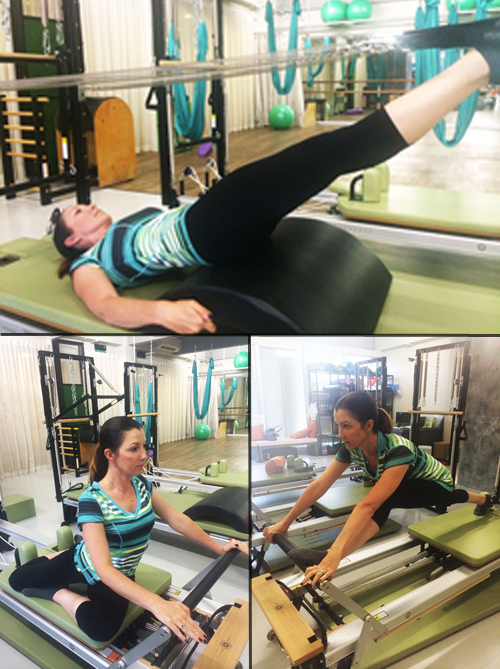
Breathe Pilates is kicking off 2016 with a series of candid interviews with our instructors as we get to know them better! Starting off this series, we have Kerstin whose Reformer and Tower I class was recently awarded ‘BEST BEGINNER FRIENDLY REFORMER CLASS” by Shape Sports Award 2016.
Hi Kerstin! Tell us more about your background. What inspired to become a Pilates Instructor?
I’m originally from a small place in Germany called Gladbeck. My professional background is in nursing and I have practiced as a specialized nurse for intensive care and anesthesia for quite a long time. What got me started in Pilates was due to my involvement in sports such as volleyball, skiing, running etc. About 10 years ago my husband and I had the opportunity to live and work in India for a few years. It was there that I fell in love with pilates and quickly became a regular with a 2-3 per week routine.
My love of pilates was noticed by the owner of the studio who suggested that I became an instructor. I jumped at the opportunity immediately and in early 2009, did my trainer certification before heading back to Germany.

Tell us more about your career as a Pilates Instructor and how did you get to where you are now?
While back in Germany, I was teaching Pilates while working as a nurse at a hospital. But I decided to take the plunge to become a full-time Pilates teacher when I relocated to Singapore 4 years ago. I found an interest in learning more about Pilates, specifically with regards to post rehab, manual therapy and the requirements for injuries and special populations. That’s probably the reason why a large percentage of my current clients come after rehab or with pre-existing issues.
Being able to make even a slight difference in their health and recovery greatly satisfies me. As for new clients, I am excited when I am able to introduce them to Pilates and show them how to control certain muscles that they hardly utilize. Simply put, I hope to make a difference to an individual’s health and recovery.

What would your advice be to new clients just starting out on their Pilates Journey?
Firstly, I believe that it is important for new clients to get a good foundation in terms of core strength, coordination and body awareness. My advise to new clients is to try and stick to one trainer in the beginning as consistent education in terms of teaching style and understanding each other. Having a consistent education more often than not will get people to a good level of Pilates faster.
Once the client have a good basic foundation, they can definitely branch out and perhaps try other types of Pilates to complement their existing classes or interests.
Secondly, having a realistic and clear expectation often helps. Pilates is not a typical gym strength training regime. It is about body awareness, posture, core strength and not purely about muscle growth. That doesn’t mean that it cannot be very challenging as many other can attest to.
Lastly, be patient with yourself. It is a journey and not a race. If the exercise is consistent and focused, the results will come.
Describe your perfect weekend in Singapore!
That’s actually quite easy. A bit of relaxing by the pool together with some sports with my husband and good food. My husband runs ultra-marathons and I love to accompany him on his training runs with a mountain bike or inline skates. Food here is really delicious and there a weekend can’t be considered good without eating well!
You are in great shape! What is your personal exercise regime like?
It is actually slightly unstructured but I like to throw in quick Pilates session for myself in between classes. I also get a bit of a workout during my own classes because I actually do something like a “dry training” with the clients; for example, when I tell them to squeeze their glutes for a specific exercise, I will squeeze mine as well. You can burn quite a bit of energy participating in a class like that. This can burn quite a fair bit of energy participating in classes like that. End of last year, I also started yoga and try to get some cardio workouts at the gym when time permits.
What are your favourite restaurants and bars in Singapore?
My husband and I love exploring local hawker centers, with probably the one at Old Airport Road being the favorite so far. On the other hand we also love trying new restaurants. What I like most are places with a cozy atmosphere, good service, and hearty food that’s not entirely over the top. A restaurant that I like going back to is Senso, a lovely Italian restaurant close to Chinatown. But I’m as happy with a bit of Mexican grub and a frozen Margarita at Cha Cha Cha in Holland Village. Both my husband and I love al fresco dining so all my favorite hangouts need to at least have the mentioned!
What are your hopes and dreams for the future – Where do you see yourself in five years?
I very much enjoy what I’m doing right now, and I love living in Singapore. So, there is actually not that much that I’d like to change in the near future. What I’d like to do instead is to simply try and learn more about Pilates and continuously become better as a teacher. Besides that, I’d only love for us to stay heathy.








